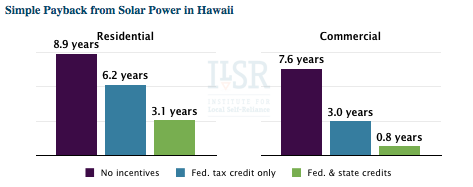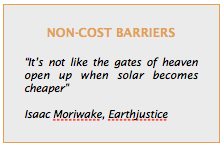Solar has crossed a major threshold in Hawaii. The state’s homes and businesses can cut their electric bills with unsubsidized solar power, but are also discovering that cheap solar is not a panacea. As the tide of solar costs has receded, a number of unexpected barriers have emerged.
 An island state reliant on imported oil for 83% of its electricity generation, Hawaii is fertile ground for solar power. The recent combination of rising oil prices and falling solar prices created a dramatic shift toward people generating their own electricity. With solar economics virtually unmatched in the U.S., Hawaii’s situation begs this question: when unsubsidized solar competes favorably with grid electricity, can anything stand in its way?
An island state reliant on imported oil for 83% of its electricity generation, Hawaii is fertile ground for solar power. The recent combination of rising oil prices and falling solar prices created a dramatic shift toward people generating their own electricity. With solar economics virtually unmatched in the U.S., Hawaii’s situation begs this question: when unsubsidized solar competes favorably with grid electricity, can anything stand in its way?
Unfortunately, yes.
Hawaii residents and businesses have unearthed the complexities of shifting from an electricity system where everyone is a consumer to one where many people are self-reliant energy producers. While the economics of solar continue to improve, a number of unexpected barriers have arisen. One quarter of homes seeking solar require expensive electrical upgrades. Local governments are struggling with the tidal wave of permit requests for building solar – as many as 70% of permit applications in Honolulu are for solar power!
 Utilities are also reluctant to give up their market dominance. Only recently did solar advocates succeed in overcoming the antiquated 15% rule that limited interconnections of solar power to 15% of grid capacity. The revised rule may expand the limit to 25%, but that still only accommodates half of the state’s solar potential on rooftops alone.
Utilities are also reluctant to give up their market dominance. Only recently did solar advocates succeed in overcoming the antiquated 15% rule that limited interconnections of solar power to 15% of grid capacity. The revised rule may expand the limit to 25%, but that still only accommodates half of the state’s solar potential on rooftops alone.
These low limits meant that in recent months nearly 90% of commercial solar projects were told by the islands’ utilities that they face a costly and lengthy interconnection study to come online. “The most common response to running into the specter of triggering a … study is for the customer to give up on their ambitions for renewable energy,” says a local solar developer.
The issue of cost hasn’t completely evaporated, either. Prospective solar producers can still get federal and state tax credits that considerably shorten the payback period for solar power. Political backlash led to a compromise bill for reducing the state incentive that failed in the final minutes of the 2012 legislative session. It could go poorly for the industry if it doesn’t pass soon, since the value of going solar comes from taxpayers’ pockets.
The post-grid parity lessons from Hawaii will be crucial for cities and states on the mainland from San Diego to New York City to Phoenix. In all, 100 million Americans will live in cities (these and others) that the Institute for Local Self-Reliance (ILSR) forecasts will reach solar grid parity in the next decade.
Will cheap solar open the floodgates or will poor policies and reluctant utilities hold it back? The Aloha State provides some answers.
You can read more about them from ILSR’s new report: Hawaiian Sunblock: Solar Facing Unexpected Barriers Despite Low Cost.


